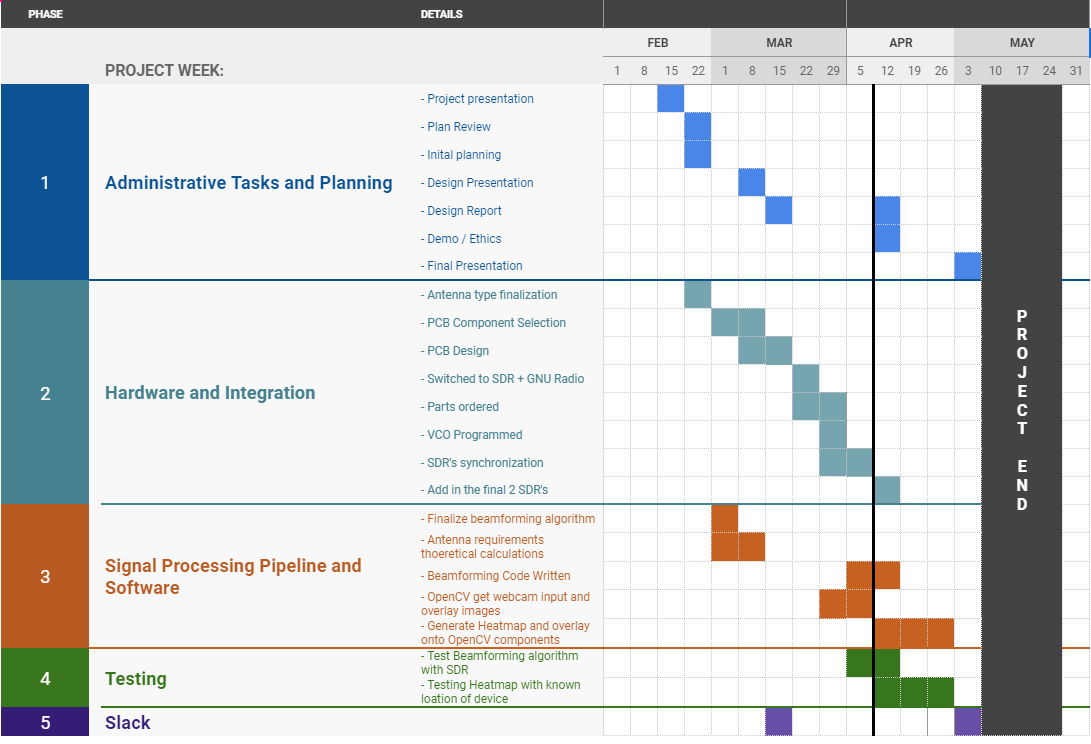Enock’s Status Report 04/24/2021
This week and the last week during carnival Vrishab and I worked on collecting a lot of data from our antenna configuration in order to see if the two antennas we had were properly synced and picking up proper signals. We found out that in our test environment in the ECE lab there were WiFi signals on our channel that were interfering with our calculations and so we were able to remove them from the network when testing which fixed all of our issues. After removing these devices we found that our signals were synced properly and correlation worked well and we could achieve and angle of arrival from the data. From here we integrated two more antennas for the full 4 antenna design which was a very smooth transition. Upon adding the new antennas all we had to do was account for N=4 antennas in our code rather than N=2 and everything worked perfectly.
We then spent time collecting data with 4 antennas and performing beamforming with two devices in the room and calculating the angle of arrival from these devices which worked for us. During this time of testing Txanton was able to send up the heatmap overlay code which we were able integrate into the system with our webcam fairly easily.
The objective for next week will be to integrate the webcam such that it interfaces with our angle of arrival data since currently all we interfaced currently is dummy data onto the webcam input. We will also take measurements to figure out our resolution to see if it matches our initial goals.
Updated Schedule

Enock’s Status Report for 04/10/2021
This week Vrishab and I spent time on the real time signal processing in time for demo. Through this we were able to start programming and finishing the antenna capture design,
For real time processing we were able to write python classes and functions that interfaced with GNURadio such that we were able to capture real-time daata and send it through UDP so that this data could be processed. We were able to set it up such that the laptop (Macbook) acted as the client and the antennas (surface tablet/SDRs) acted as the server such that the server would send the collected data from the servers to the client which would do all the processing for the correlation and angle of arrival data.
However, we faced issues with the hardware as we had two SDR’s running but during real-time analysis of the QT data we noticed that one signal was always more noisy and less strong than the other which ended up having to do with our downmixer. This was discovered by switching out the SMA cable, SMA-RPSMA adapters, and even VCO’s and antennas. We found out that through this process that one of the downmixer outputs transmitted data less strongly than the other downmixwer we ordered which seems to be a factory default.
Upon figuring this out and changing downmixers, we were able to see similar if not almost identical signals on each antenna. We were able to see strong and accurate signals and were able to collect data that would be able to used for correlation and phase detection.
The next step for this week is to make sure the outcome of this data is suitable for beamforming and that beamforming works come demo time. We are sure that our data is correct, but we must check that the beamfoming output is also correct for the heatmap overlay. As we work on this, we will provide dummy data to Txanton such that he can create a dummy heatmap overlay in time for demo
Vrishab’s Status Report for 03/27/2021
Signal Capture Pipeline Design Changes
Since there was no status report last week due to the midsemester break, we have made some considerable progress — as well as some significant changes — to our beamforming architecture. Based on the feedback from our presentation two weeks ago, we have decided against fabricating our own PCB to convert analog signals from the WiFi antennas to digital signals that we can process. Instead, we will be using an array of cheap SDRs (~$25 each) to capture the downconverted signals and convert them into digital signals. The downconversion will now be done using commodity downconverters, which we have already purchased and are en route.
My role was largely in organizing these changes. I also used two SDRs which we borrowed from Dr. Swarun Kumar to perform beamforming on radio signals in the FM band, which will be close to the intermittent frequency of the boards we ordered. Enock and I also met with one of Dr. Kumar’s graduate students, Atul Bansal, to further discuss possible modifications beamformer implementation, such as synchronization schemes, and to receive feedback on our implementation .
Design Report
As a group, we spent a considerable amount of time writing our design report. My contribution to this was the signal processing portions as well as miscellaneous contributions to the introduction, architechture overview, risk management, etc.
Progress Since Last Report
We have finalized our implementation and have ordered parts. We have a working beamformer implementation for signals in the FM band.
Plans for Next Week
Once our parts arrive we will begin integration and testing. Since the ordered parts are development boards, which are designed to be plug-and-play, we should be able to begin testing without delay.
